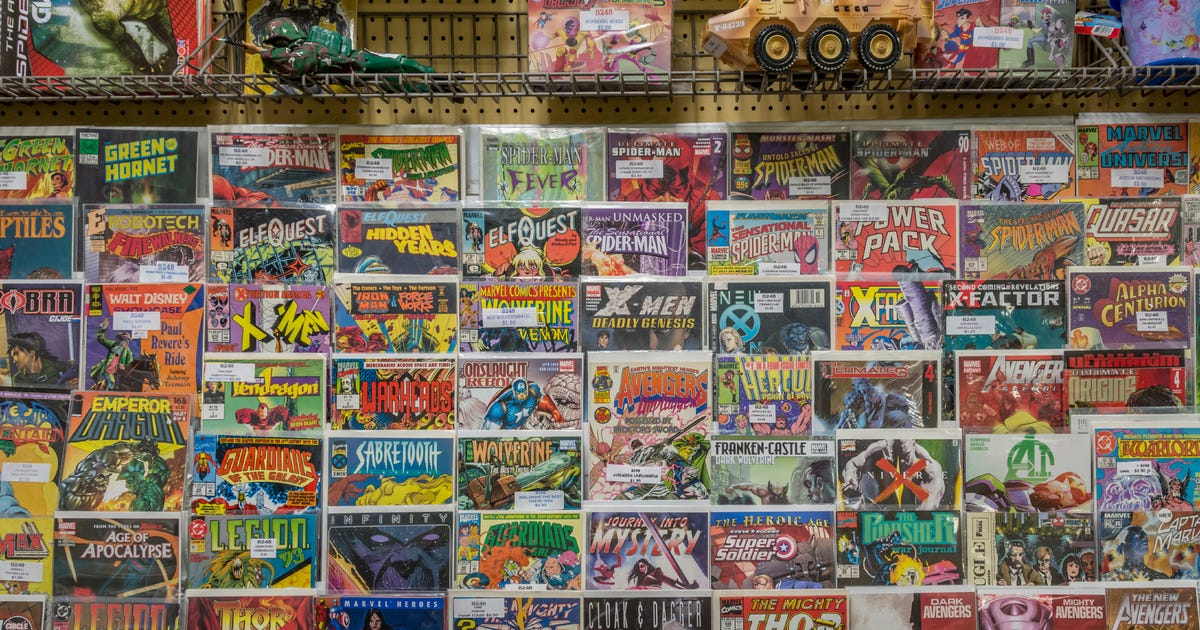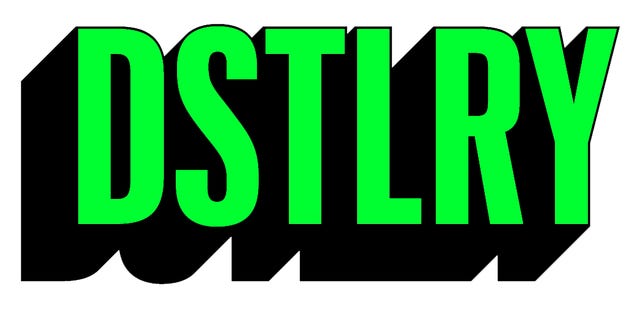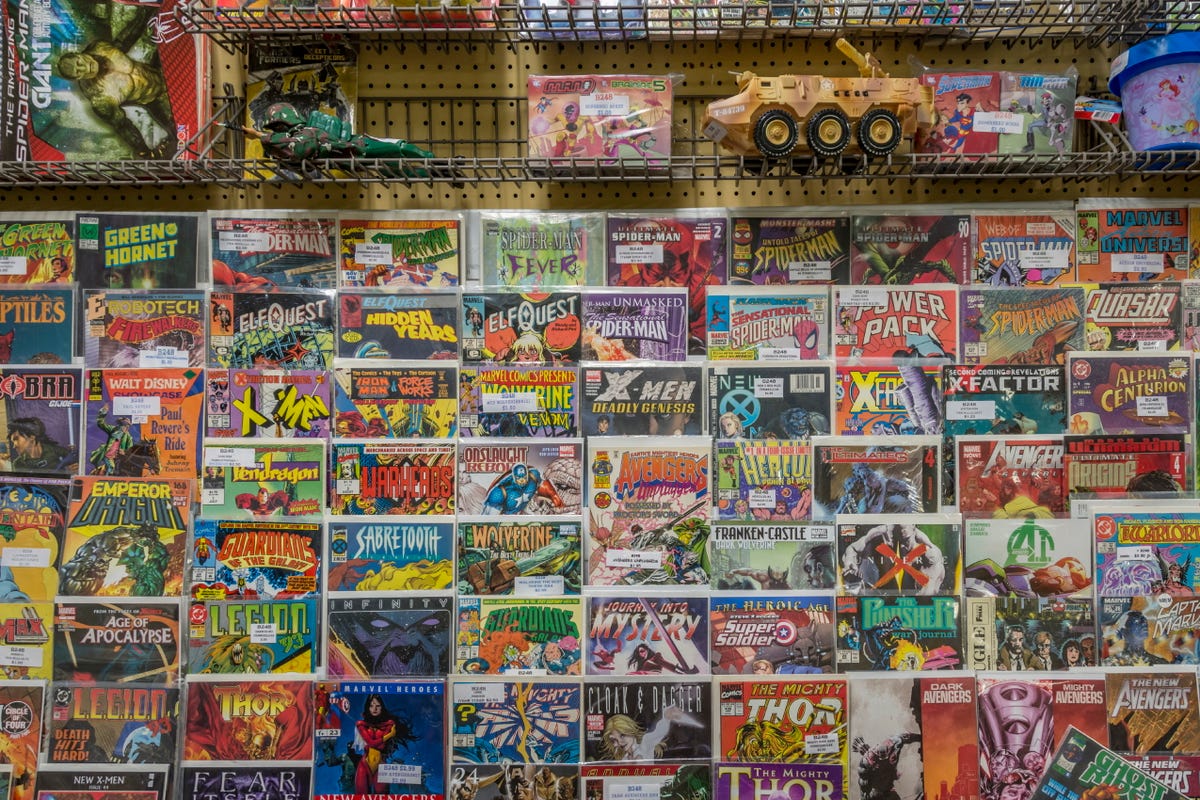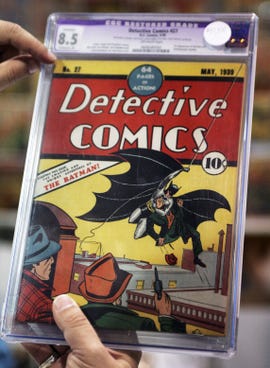
Two former Comixology heads unveiled a new creator-owned comics and collectibles publisher Thursday called Dstlry. David Steinberger, co-founder and former CEO of Comixology, and Chip Mosher, former Comixology head of content, hope the new publisher shifts the industry around creator-owned comics and collectibles.
Dstlry will offer a limited number of physical and digital items for sale online and in brick-and-mortar stores. Owners of digital items will then be able to sell their items in the Dstlry marketplace, and the original creators will get a percentage of what the item sells for.

Dstlry’s logo.
Dstlry
Steinberger and Mosher told me in an interview they hope Dstlry can help alleviate pains some creators have felt in the comics industry when it comes to compensation. While some comic characters and stories make millions of dollars as a result of films, some creators have felt left out in the cold.
Ed Brubaker and Steve Epting, for example, transformed Bucky Barnes into the Winter Soldier in 2005. However, Brubaker wrote in his newsletter in 2021 that he feels he and Epting haven’t been adequately compensated for their work given the character’s success in multiple Marvel Cinematic Universe films and shows.
“For the most part all Steve Epting and I have gotten for creating the Winter Soldier and his storyline is a ‘thanks’ here or there,” Brubaker wrote. “I’ve even seen higher-ups on the publishing side try to take credit for my work a few times, which was pretty galling.”
Steinberger and Mosher saw these issues and wanted to be part of the solution by making sure creators are treated well so they can produce their best work for readers.
“We looked at all these problems creators had and we tried to fix that,” Mosher said. “We knew if we fix stuff for creators across the board, on a lot of different levels, then we’d be delivering the best thing for the customers.”

Ed Brubaker (pictured) and Steve Epting brought Bucky Barnes back to life as the Winter Soldier in 2005.
Jeff Kravitz/Getty Images
“Without [creators] there’s nothing, and they don’t always get treated that way when their material that they create becomes $100 million movies or billion dollar movies,” Steinberger said. Dstlry is about “honoring their contribution … there’s a joy in trying to correct what is currently out there.”
Steinberger and Mosher also said they hope Dstlry will bring the fun of collecting print issues to the digital space. They said when new issues of a comic are released, digital copies of the comic will be sold online at dstlry.co for one week until the next issue comes out.
“However many digital copies get sold between Wednesday and Tuesday, that’s it, never any more again,” Mosher said.
But people will still be able to get their hands on digital issues through the Dstlry marketplace, and mass market digital trade collections will be available more broadly. Physical copies will be available in local comic shops, too. Some creators will also be given complimentary digital copies of comics they can give out to fans.
Steinberger and Mosher said they hope this will help readers feel closer to all the creators that are publishing through Dstlry.
The list of Dstlry founding creators includes well-known writers and artists like Eisner Award winners Scott Snyder, Becky Cloonan and James Tynion IV. Dstlry’s advisory board consists of film producer Lorenzo di Bonaventura, video game industry veteran John Schappert and tech strategist Mike Vorhaus.
You can find the full list of Dstlry’s founding creators at the end of this story.

Eisner Award winner Scott Snyder is one of the founding creators of Dstlry.
Roy Rochlin/Getty Images
“Artistic growth is spurred when its creators are nurtured and properly compensated for their achievements,” Bonaventura said in a news release. “This new system and its shared equity model will provide an invigorating environment which will foster great storytelling.”
And understanding how to build that kind of environment is something Steinberger and Mosher said they developed in their tenures at Comixology.
“Learning how to work with creators at a high level and do the best for them, which led to the best products, was one of the big things I learned,” Mosher said, referring to individual issues.
“You want to have empathy for [creators],” Steinberger said. “You want to understand what they need, and try to deliver that every time.”
More details about Dstlry’s plans will be revealed later this year.

Readers will still be able to get Dstlry comics at comic shops if they want physical copies.
Getty Images
How Dstlry could affect the comic industry
The type of commodities market Dstlry is launching has a few advantages over other commodities markets.
Namely, other commodities depreciate in value after they’re used. Sneakers, for example, depreciate in value the second you put them on your feet. Cars also depreciate in value by as much as 9% to 11% as soon as you drive one off the lot, according to financial counseling firm Ramsey Solutions.

A copy of Detective Comics No. 27 sold at auction in 2022 for $1.74 million.
Spencer Weiner/Getty Images
With Dstlry’s model, people should be able to read a digital comic as many times as they want, then sell that comic on Dstlry’s digital marketplace for the price they bought the comic for, or higher. Looking to physical comics as an example, Detective Comics No. 27, which introduced Batman in 1939, sold at auction in May 2022 for $1.74 million. Granted, that’s an extreme example that most new comics won’t replicate anytime soon. But Dstlry wants to create a system where creators still make money from the sale — and resale — of their comics at any time.
That also means if you get into a digital series a few months after it launches, you’ll likely have to pay a higher price for an early comic in that digital series. You’ll probably have to pay more for a physical copy of that comic, too, since those are also sold in limited quantities, but that’s also often true of traditional publishers.
Admittedly, this could create a predatory resale market. That could happen if people buy as many digital copies of a comic as they can, then once the comic goes out of print, they ask for an absurd amount of money for the digital comics on the Dstlry marketplace. However, this kind of speculation led to a comics industry crash in the ’90s. People who hope to get rich from the resale of these digital comics will have to invest wisely and understand that some of the largest payoffs come after years of waiting.
The resale of digital comics on Dstlry’s marketplace should have a benefit over physical copies of comics, though.
With physical copies of comics you need plastic covers and storage space to help keep comics secure and safe, and you’ll have to be vigilant about how they’re stored if you plan on selling them after a certain amount of time.
Digital copies of comics are limited only by the amount of space on your device. And if Dstlry offers cloud storage, people won’t even have to worry about that.

Maintaining and transporting your digital comics is easier than their physical counterparts.
Getty Images
Besides those advantages for readers, Dstlry’s benefits for creators seem obvious, and it addresses an issue some people in the sneaker community have pointed out.
Nike made over $46 billion in revenue in 2022. Footwear made up about two-thirds of that revenue, at $29 billion. The sneaker resale market alone was estimated to be worth about $10 billion in 2021, according to Axios. It isn’t known how much estimated value Nike sneakers have on the resale market, but you can see there are huge profits in the resale market that companies like Nike are cut out of.
With Dstlry’s model, each time a digital item is resold, a percentage of that sale goes back to the creators. That means creators will benefit from their work weeks, months or even years after their digital series ends. Though the percentage of an item’s resale value that creators will receive hasn’t been disclosed at this time, any percentage is better than none.
I’m not expecting Dstlry to fix issues in the comics industry overnight, or even by the end of the year. Systemic changes take time and a lot of buy-in from others, like creators and readers.
However, I believe creators should get the full benefit from their work. It’s ridiculous that someone can get rich off something a creator made while that creator gets little or nothing in return.
I’m hopeful for Dstlry, and I plan on supporting the publisher and its creators in the future.
For more on comics, check out the best comic to read if you’re sick of superheroes, Scott Snyder’s creator-owned comic Dark Spaces: Wildfire and a graphic novel that imagines what it would look like if Jan. 6 succeeded.
Here’s the full list of Dstlry’s founding creators:
